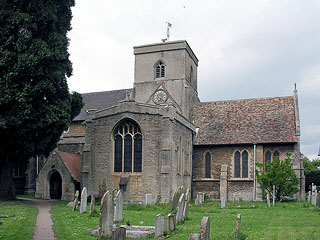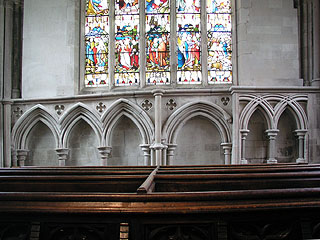We arrived just as someone was opening up the church for a wedding, which was quite lucky since I gather that it is normally kept closed. This is a pity, since it is (possibly with the exception of Trumpington) the most interesting church in the villages-that-are-sort-of-suburbs-of-Cambridge-really, and I'd heartily recommend a visit.
This is a cruciform church, with a little central tower. There is a fine Early English chancel, albeit much restored by George Gilbert Scott, and a short nave with some wierd tracery in the west window apparently by a thirty year old Bodley (who also, as it happens, designed the court of King's College where I'm living at the moment - maturity, though, brought more competence). The crossing is nice - Pevsner thinks it's 14th century.
The transepts are the really exciting thing about this church, though. They are a jumble of utterly beautiful Early English carving. The north and south faces are filled with blind arcading and piscinae. The lines of the arches are fluid, crossing and re-crossing. The pale stone almost gives the impression of piped icing on a cake.
The piscinae are particular interesting - each double piscina is surmounted by rounded arches forming two little pointed arches. Each arch is composed of three concentric arcs, which interlock and flow through each other. The overall effect is a bit jumbled, but very beautiful. The east windows in the south transept are in the same style, with a particularly nice niche. In the north transept they have been replaced by a pair of perpendicular windows, but in proportion with the rest.
There's a strange square-headed niche which has been placed on the wall below the window and awkwardly covers the lower right hand corner. The decoration is, again, very good - I wonder whether it might have been a guild chapel, or something like that, and this the niche for their patron saint. There has been a lot of money lavished on this place, over the years, and it shows
the church is normally locked

